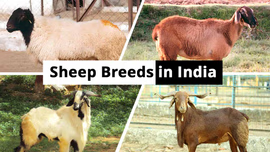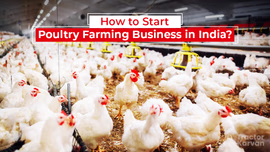Fish Farming in India: A Profitable Enterprise to Start

Fish is considered as the healthiest forms of animal protein. It is a very popular food item in India due to its immense benefits such as proteins, good fats, vitamins and minerals. Fish farming in India is now being increasingly adopted by farmers as it is a highly profitable enterprise to start. In today’s blog, we will explore everything about fish farming with its complete starting process in India.
Table of Contents
- Introduction
- Types of Fish Farming
- Why Farmers are Increasingly Adopting Fish Farming in India?
- How to Start Fish Farming Business in India?
- Challenges in Fish Farming in India
Introduction
Fish farming, also known as aquaculture or pisciculture, is the practice of breeding, raising and harvesting of fish, for consumption in aquatic environments like ponds, rivers, lakes and oceans. The primary purpose of commercially growing fish are profits. It is one of the oldest occupations in India and is one of the surest ways to enhance the livelihood and income of small farmers. The popular fish varieties grown in India are Rohu, Catla, Shrimp, Pomfret, and Mackerel.
The fisheries sector is growing over the past two decades. Today, India is the second largest fish producing country with around 8% share in global fish production. In 2025-26 budget, Government of India proposed the highest ever total annual budgetary support of Rs. 2,703.67 crores for the fisheries sector. The fish production has been increased from 95.79 lakh tons (2013-14) to 184.02 lakh tons (2023-24). The Kisan Credit Card (KCC) lending limit has also been increased from Rs. 3 lakhs to Rs. 5 lakhs to enhance credit accessibility for fishers. The inland fish production contributes more than 70% of the total fish production and culture-based farming, especially pond fish farming, is more prevalent in the country today.
Types of Fish farming

There are different types of fish farming practiced in India. Before starting a fish farming business, you must know these types. Let’s have a look.
- Pond Culture: In pond culture, fishes are usually raised in freshwater ponds.
- Cage Culture: In cage system, fishes are raised in enclosed environments such as nets within seas or lakes.
- Integrated multitrophic aquaculture (IMTA): It is an integrated type of system where multiple species of fish can be grown, and it maintains food chain and overall effectiveness of the environment.
Why Farmers are Increasingly Adopting Fish Farming in India?
Increasingly farmers in India, especially marginal and small farmers, are adopting fish farming as it is highly remunerative. The benefit to cost ratio of fish farming ranges between 1.7 to 1.9, which is one of the highest among all profitable livestock business in India. Following are the reasons for increasing adoption:
- Diminishing land for food crops has necessitated adoption of fish farming as an alternative source of livelihood.
- Fish is the least expensive source of animal protein, amino acids and fatty acids.
- Availability of large networks of pond and tanks in the country.
- Acceptance of Indian fish and fish products in the international market.
- Higher growth rates in aquaculture.
- Government support and programmes such as Pradhan Mantri Matsya Sampada Yojana
How to Start a Fish Farming Business in India?
Registration of Certificate and Fishing License from the respective State’s Department of Fisheries is necessary to start a fish farming business. Following are the steps to start a fish farming business for successful and bountiful production of fish meanders.
Conduct Market Research
- Before starting any agri-business, thorough market research is required to know
- Market demand in your area for the fish in general.
- Fish species mostly consumed in your area and at the same time profitable to rear.
- Cost of establishing a cage, depending upon the type of water source.
- Extent of government subsidies provided on starting a fish farm.
- Presence of any extension of government to provide training such as Krishi Vigyan Kendras (KVKs).
- Requirement for a license for starting a fish farm in your area.
Select Right Location
Selecting the right location to start a fish farm is most critical. While selecting a location, you should ensure the following:
- The site you choose should have the good water supply all year round.
- It should be constructed near the natural water bodies like ponds or rivers.
- The water should have the neutral pH. Otherwise, it will harm or may become the reason for the death of fishes.
- Other factors include market aspects, transportation, accessibility, infrastructural facilities, etc.
Select the Right Fish Variety
In India commercial pond culture for growing fish is prevalent; thus, while selecting the right fish species for rearing in India, you must look at few criteria as given below:
- Species must be adaptable to undrained environment of pond.
- They exhibit a faster growth rate in ponds.
- They are efficient utilisers of natural food resources and efficient converter of artificial feed.
- They are hardy and resistance to any form of disease.
- They are easy to breed and have multiple breeding frequency or prolonged breeding period.
- They are compatible with other species of fishes.
- They have a high market demand and command high price.
So, depending upon your requirements, you can select the right species of fish to rear. In India, usually Catla, Rohu and Mrigala are popular among farmers and new aquapreneurs.
With the government providing support for saline water fisheries in states such as Uttar Pradesh and Haryana, the Pungas fish species are also becoming popular to rear.
Constructing the Fish Farm
Designing a fish farm takes lot of investment and effort. But if you know the optimum size of farm that could ensure optimum production of fish, then it is good. As per the FAO, following dimension are better for fish farming in pond:
- Minimum size of pond must be 300 square meters.
- The shape should be either rectangular or square.
- The pond must be shallow having a water depth from 60 cm to 90 cm.
- Must have better and simple inlets and outlets for water.
- The banks of the ponds must be 50 cm higher than the top layer of water.
- The banks must have good slopes on sides and wall must be tightly packed with soil.
Besides, you should also look for any subsidy provided by the government. For instance, government provides subsidy in the 40 – 60% range on various items under the Pradhan Mantri Matsya Sampada Yojana (PMMSY).
Sourcing Quality Seed and Feed
Sourcing healthy and quality seed (juvenile fish) is critical for the proper growth of fish. Do ensure that you procure the fish seed from a certified government agency or nursery and the seeds are in alignment with your chosen fish species.
Providing required feed at regular interval ensures that fish keeps on getting essential nutrients and grow healthy. Besides, healthy feed also increases their ability to reproduce quality seeds.
Essentially three types of fish feeds are given to fishes. These are:
- Natural feed: worms, insects, aquatic plants, etc.
- Supplementary feed: agricultural by-products, kitchen wastes, etc
- Complete feed: mixture of carefully selected ingredients to provide all the essential nutrients
Monitoring and Management of Fish Farms
Regular inspection and monitoring of water quality, pond and fish help identify any disease outbreak and prevent any significant damage to fish growth. Besides, implementing the biosecurity measure such as controlling predators effectively is essential.
Harvesting of Fish
Harvesting fish requires extreme caution. While harvesting you must keep following points in mind:
- Do not harvest before 5 months. Post-this, you can harvest few big fishes and then all by the end of 6 months.
- Always harvest the fish by draining or partially draining the water out of pond or use a seine net measuring 3 – 3.5 cm.
- Remember to harvest the fish early in the morning when it is cool.
- After harvesting fish, store them in a watertight container.
- Harvest the fish at different times and not at a time if you are harvesting all the fish. Only harvest what can be sold in a day.
What are the Challenges in Fish Farming in India?
- Use of traditional methods of fish culture and harvesting.
- Poor access to quality feed & seed, poor processing facility and poor access to credits.
- Lack of knowledge among farmers about government policies and subsidies.
- Inadequate and poor infrastructure.
- Lack of diversity in culture of fish species.
- Lower productivity due to incidences of diseases.
Amidst these challenges, the multi-dimensional role of KVKs is critical in nurturing of aquaculture and aquapreneurs, promoting of fish farming among poor and creating awareness.
Frequently Asked Questions On Fish Farming Business in India
1. What is fish farming?
Fish farming, a type of aquaculture, is a process of raising fish for consumption and profits.
2. How to start fish farming?
Starting fish farming require proper research and planning, training and sufficient knowledge, initial investment, and infrastructure development.
3. What is fish farming called?
Fish farming is commonly called aquaculture or pisciculture.
4. Is fish farming a profitable business in India?
Yes, fish farming is a profitable business in India with a benefit to cost ratio of 1.7 – 1.9.
5. How much land is required for fish farming?
The land requirement for fish farming depends on the pond size and the number of fishes to be reared.
6. How much subsidy do you get for fish farming?
The government offers subsidy under PMMSY scheme within a range of 40 to 60%.
7. What are the equipment needed for fish farming?
The equipment needed for fish farming includes, Water tester, aerators, fish feeders, pond pumps, fish graders, thermometers and generators.
8. What are the equipment needed for fish farming?
The equipment needed for fish farming includes, Water tester, aerators, fish feeders, pond pumps, fish graders, thermometers and generators.


Related Blogs












